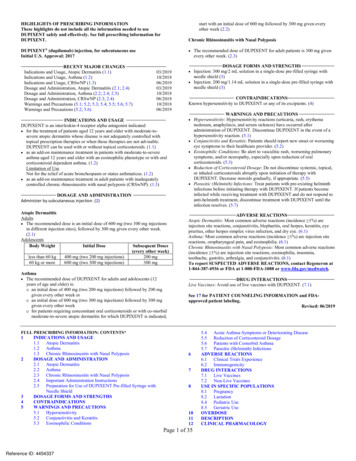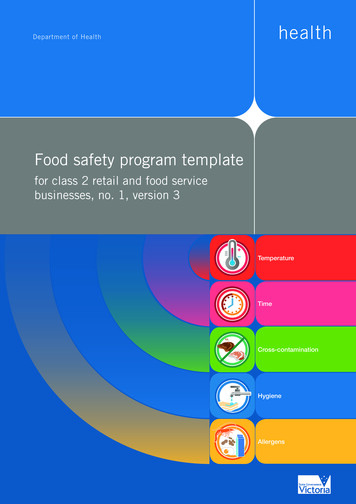
Transcription
start with an initial dose of 600 mg followed by 300 mg given everyother week (2.2)HIGHLIGHTS OF PRESCRIBING INFORMATIONThese highlights do not include all the information needed to useDUPIXENT safely and effectively. See full prescribing information forDUPIXENT.Chronic Rhinosinusitis with Nasal PolyposisDUPIXENT (dupilumab) injection, for subcutaneous useInitial U.S. Approval: 2017 The recommended dose of DUPIXENT for adult patients is 300 mg givenevery other week. (2.3)RECENT MAJOR CHANGESIndications and Usage, Atopic Dermatitis (1.1)03/2019Indications and Usage, Asthma (1.2)10/2018Indications and Usage, CRSwNP (1.3)06/2019Dosage and Administration, Atopic Dermatitis (2.1; 2.4)03/2019Dosage and Administration, Asthma (2.2; 2.4; 2.5)10/2018Dosage and Administration, CRSwNP (2.3; 2.4)06/2019Warnings and Precautions (5.1; 5.2; 5.3; 5.4; 5.5; 5.6; 5.7)10/2018Warnings and Precautions (5.2; 5.6)06/2019INDICATIONS AND USAGEDUPIXENT is an interleukin-4 receptor alpha antagonist indicated: for the treatment of patients aged 12 years and older with moderate-tosevere atopic dermatitis whose disease is not adequately controlled withtopical prescription therapies or when those therapies are not advisable.DUPIXENT can be used with or without topical corticosteroids. (1.1) as an add-on maintenance treatment in patients with moderate-to-severeasthma aged 12 years and older with an eosinophilic phenotype or with oralcorticosteroid dependent asthma. (1.2)Limitation of UseNot for the relief of acute bronchospasm or status asthmaticus. (1.2) as an add-on maintenance treatment in adult patients with inadequatelycontrolled chronic rhinosinusitis with nasal polyposis (CRSwNP). (1.3)DOSAGE FORMS AND STRENGTHS Injection: 300 mg/2 mL solution in a single-dose pre-filled syringe withneedle shield (3) Injection: 200 mg/1.14 mL solution in a single-dose pre-filled syringe withneedle shield (3)CONTRAINDICATIONSKnown hypersensitivity to DUPIXENT or any of its excipients. (4) DOSAGE AND ADMINISTRATIONAdminister by subcutaneous injection. (2)Atopic DermatitisAdults The recommended dose is an initial dose of 600 mg (two 300 mg injectionsin different injection sites), followed by 300 mg given every other week.(2.1)AdolescentsBody WeightInitial DoseSubsequent Doses(every other week)less than 60 kg400 mg (two 200 mg injections)200 mg60 kg or more600 mg (two 300 mg injections)300 mgAsthma The recommended dose of DUPIXENT for adults and adolescents (12years of age and older) is:o an initial dose of 400 mg (two 200 mg injections) followed by 200 mggiven every other week oro an initial dose of 600 mg (two 300 mg injections) followed by 300 mggiven every other weeko for patients requiring concomitant oral corticosteroids or with co-morbidmoderate-to-severe atopic dermatitis for which DUPIXENT is indicated,2345INDICATIONS AND USAGE1.1 Atopic Dermatitis1.2 Asthma1.3 Chronic Rhinosinusitis with Nasal PolyposisDOSAGE AND ADMINISTRATION2.1 Atopic Dermatitis2.2 Asthma2.3 Chronic Rhinosinusitis with Nasal Polyposis2.4 Important Administration Instructions2.5 Preparation for Use of DUPIXENT Pre-filled Syringe withNeedle ShieldDOSAGE FORMS AND STRENGTHSCONTRAINDICATIONSWARNINGS AND PRECAUTIONS5.1 Hypersensitivity5.2 Conjunctivitis and Keratitis5.3 Eosinophilic Conditionsnodosum, anaphylaxis, and serum sickness) have occurred afteradministration of DUPIXENT. Discontinue DUPIXENT in the event of ahypersensitivity reaction. (5.1)Conjunctivitis and Keratitis: Patients should report new onset or worseningeye symptoms to their healthcare provider. (5.2)Eosinophilic Conditions: Be alert to vasculitic rash, worsening pulmonarysymptoms, and/or neuropathy, especially upon reduction of oralcorticosteroids. (5.3)Reduction of Corticosteroid Dosage: Do not discontinue systemic, topical,or inhaled corticosteroids abruptly upon initiation of therapy withDUPIXENT. Decrease steroids gradually, if appropriate. (5.5)Parasitic (Helminth) Infections: Treat patients with pre-existing helminthinfections before initiating therapy with DUPIXENT. If patients becomeinfected while receiving treatment with DUPIXENT and do not respond toanti-helminth treatment, discontinue treatment with DUPIXENT until theinfection resolves. (5.7)DRUG INTERACTIONSLive Vaccines: Avoid use of live vaccines with DUPIXENT. (7.1)See 17 for PATIENT COUNSELING INFORMATION and FDAapproved patient labeling.Revised: 06/2019678101112Page 1 of 35Reference ID: 4454337ADVERSE REACTIONSAtopic Dermatitis: Most common adverse reactions (incidence 1%) areinjection site reactions, conjunctivitis, blepharitis, oral herpes, keratitis, eyepruritus, other herpes simplex virus infection, and dry eye. (6.1)Asthma: Most common adverse reactions (incidence 1%) are injection sitereactions, oropharyngeal pain, and eosinophilia. (6.1)Chronic Rhinosinusitis with Nasal Polyposis: Most common adverse reactions(incidence 1%) are injection site reactions, eosinophilia, insomnia,toothache, gastritis, arthralgia, and conjunctivitis. (6.1)To report SUSPECTED ADVERSE REACTIONS, contact Regeneron at1-844-387-4936 or FDA at 1-800-FDA-1088 or www.fda.gov/medwatch.FULL PRESCRIBING INFORMATION: CONTENTS*1WARNINGS AND PRECAUTIONS Hypersensitivity: Hypersensitivity reactions (urticaria, rash, erythema5.4 Acute Asthma Symptoms or Deteriorating Disease5.5 Reduction of Corticosteroid Dosage5.6 Patients with Comorbid Asthma5.7 Parasitic (Helminth) InfectionsADVERSE REACTIONS6.1 Clinical Trials Experience6.2 ImmunogenicityDRUG INTERACTIONS7.1 Live Vaccines7.2 Non-Live VaccinesUSE IN SPECIFIC POPULATIONS8.1 Pregnancy8.2 Lactation8.4 Pediatric Use8.5 Geriatric UseOVERDOSEDESCRIPTIONCLINICAL PHARMACOLOGY
131412.1 Mechanism of Action12.2 Pharmacodynamics12.3 PharmacokineticsNONCLINICAL TOXICOLOGY13.1 Carcinogenesis, Mutagenesis, Impairment of FertilityCLINICAL STUDIES14.1 Atopic Dermatitis14.2 Asthma14.3 Chronic Rhinosinusitis with Nasal Polyposis1617*Sections or subsections omitted from the full prescribing informationare not listedPage 2 of 35Reference ID: 4454337HOW SUPPLIED/STORAGE AND HANDLING16.1 How Supplied16.2 Storage and HandlingPATIENT COUNSELING INFORMATION
FULL PRESCRIBING INFORMATION1INDICATIONS AND USAGEDUPIXENT is indicated for the following diseases:1.1Atopic DermatitisDUPIXENT is indicated for the treatment of patients aged 12 years and older with moderate-tosevere atopic dermatitis whose disease is not adequately controlled with topical prescriptiontherapies or when those therapies are not advisable. DUPIXENT can be used with or withouttopical corticosteroids.1.2AsthmaDUPIXENT is indicated as an add-on maintenance treatment in patients with moderate-to-severeasthma aged 12 years and older with an eosinophilic phenotype or with oral corticosteroiddependent asthma.Limitation of UseDUPIXENT is not indicated for the relief of acute bronchospasm or status asthmaticus.1.3Chronic Rhinosinusitis with Nasal PolyposisDUPIXENT is indicated as an add-on maintenance treatment in adult patients with inadequatelycontrolled chronic rhinosinusitis with nasal polyposis (CRSwNP).2DOSAGE AND ADMINISTRATIONDUPIXENT is administered by subcutaneous injection.2.1Atopic DermatitisDosing in AdultsThe recommended dose of DUPIXENT for adult patients is an initial dose of 600 mg (two300 mg injections), followed by 300 mg given every other week.Dosing in AdolescentsThe recommended dose of DUPIXENT for patients 12 to 17 years of age is specified in Table 1.Table 1:Dose of DUPIXENT for Subcutaneous Administration in Adolescent PatientsBody Weightless than 60 kg60 kg or moreInitial Dose400 mg (two 200 mg injections)600 mg (two 300 mg injections)Page 3 of 35Reference ID: 4454337Subsequent Doses (every other week)200 mg300 mg
Concomitant Topical TherapiesDUPIXENT can be used with or without topical corticosteroids. Topical calcineurin inhibitorsmay be used, but should be reserved for problem areas only, such as the face, neck, intertriginousand genital areas.2.2AsthmaThe recommended dose of DUPIXENT for adults and adolescents (12 years of age and older) is: an initial dose of 400 mg (two 200 mg injections) followed by 200 mg given every otherweek or an initial dose of 600 mg (two 300 mg injections) followed by 300 mg given every otherweek for patients with oral corticosteroids-dependent asthma, or with co-morbid moderate-tosevere atopic dermatitis for which DUPIXENT is indicated, start with an initial dose of600 mg followed by 300 mg given every other week2.3Chronic Rhinosinusitis with Nasal PolyposisThe recommended dose of DUPIXENT for adult patients is 300 mg given every other week.2.4Important Administration InstructionsDUPIXENT is intended for use under the guidance of a healthcare provider. A patient may selfinject DUPIXENT after training in subcutaneous injection technique using the pre-filled syringe.Provide proper training to patients and/or caregivers on the preparation and administration ofDUPIXENT prior to use according to the “Instructions for Use”.For atopic dermatitis and asthma patients taking an initial 600 mg dose, administer each of thetwo DUPIXENT 300 mg injections at different injection sites.For asthma patients taking an initial 400 mg dose, administer each of the two DUPIXENT 200mg injections at different injection sites.Administer subcutaneous injection into the thigh or abdomen, except for the 2 inches (5 cm)around the navel. The upper arm can also be used if a caregiver administers the injection.Rotate the injection site with each injection. DO NOT inject DUPIXENT into skin that is tender,damaged, bruised, or scarred.If a dose is missed, instruct the patient to administer the injection within 7 days from the misseddose and then resume the patient's original schedule. If the missed dose is not administeredwithin 7 days, instruct the patient to wait until the next dose on the original schedule.The DUPIXENT “Instructions for Use” contains more detailed instructions on the preparationand administration of DUPIXENT [see Instructions for Use].Page 4 of 35Reference ID: 4454337
2.5Preparation for Use of DUPIXENT Pre-filled Syringe with NeedleShieldBefore injection, remove DUPIXENT pre-filled syringe from the refrigerator and allowDUPIXENT to reach room temperature (45 minutes for the 300 mg/2 mL pre-filled syringe and30 minutes for the 200 mg/1.14 mL pre-filled syringe) without removing the needle cap.Inspect DUPIXENT visually for particulate matter and discoloration prior to administration.DUPIXENT is a clear to slightly opalescent, colorless to pale yellow solution. Do not use if theliquid contains visible particulate matter, is discolored or cloudy (other than clear to slightlyopalescent, colorless to pale yellow). DUPIXENT does not contain preservatives; therefore,discard any unused product remaining in the pre-filled syringe.3DOSAGE FORMS AND STRENGTHSDUPIXENT is a clear to slightly opalescent, colorless to pale yellow solution available as: Injection: 300 mg/2 mL in a single-dose pre-filled syringe with needle shield Injection: 200 mg/1.14 mL in a single-dose pre-filled syringe with needle shield4CONTRAINDICATIONSDUPIXENT is contraindicated in patients who have known hypersensitivity to dupilumab or anyof its excipients [see Warnings and Precautions (5.1)].5WARNINGS AND PRECAUTIONS5.1HypersensitivityHypersensitivity reactions, including generalized urticaria, rash, erythema nodosum and serumsickness or serum sickness-like reactions, were reported in less than 1% of subjects who receivedDUPIXENT in clinical trials. Two subjects in the atopic dermatitis development programexperienced serum sickness or serum sickness-like reactions that were associated with high titersof antibodies to dupilumab. One subject in the asthma development program experiencedanaphylaxis [see Adverse Reactions (6.2)]. If a clinically significant hypersensitivity reactionoccurs, institute appropriate therapy and discontinue DUPIXENT [see Adverse Reactions (6.1,6.2)].5.2Conjunctivitis and KeratitisConjunctivitis and keratitis occurred more frequently in atopic dermatitis subjects who receivedDUPIXENT. Conjunctivitis was the most frequently reported eye disorder. Most subjects withconjunctivitis recovered or were recovering during the treatment period. Keratitis was reportedin 1% of the DUPIXENT group (1 per 100 subject-years) and in 0% of the placebo group (0 per100 subject-years) in the 16-week atopic dermatitis monotherapy trials. In the 52-weekDUPIXENT topical corticosteroids (TCS) atopic dermatitis trial, keratitis was reported in 4%of the DUPIXENT TCS group (12 per 100 subject-years) and in 0% of the placebo TCSgroup (0 per 100 subject-years). Most subjects with keratitis recovered or were recovering duringthe treatment period [see Adverse Reactions (6.1)].Page 5 of 35Reference ID: 4454337
Among asthma subjects, the frequencies of conjunctivitis and keratitis were similar betweenDUPIXENT and placebo [see Adverse Reactions (6.1)].In subjects with CRSwNP, the frequency of conjunctivitis was 2% in the DUPIXENT groupcompared to 1% in the placebo group in the 24-week safety pool; these subjects recovered. Therewere no cases of keratitis reported in the CRSwNP development program [see Adverse Reactions(6.1)].Advise patients to report new onset or worsening eye symptoms to their healthcare provider.5.3Eosinophilic ConditionsPatients being treated for asthma may present with serious systemic eosinophilia sometimespresenting with clinical features of eosinophilic pneumonia or vasculitis consistent witheosinophilic granulomatosis with polyangiitis, conditions which are often treated with systemiccorticosteroid therapy. These events may be associated with the reduction of oral corticosteroidtherapy. Physicians should be alert to vasculitic rash, worsening pulmonary symptoms, cardiaccomplications, and/or neuropathy presenting in their patients with eosinophilia. Cases ofeosinophilic pneumonia were reported in adult patients who participated in the asthmadevelopment program and cases of vasculitis consistent with eosinophilic granulomatosis withpolyangiitis have been reported with DUPIXENT in adult patients who participated in theasthma development program as well as in adult patients with co-morbid asthma in the CRSwNPdevelopment program. A causal association between DUPIXENT and these conditions has notbeen established.5.4Acute Asthma Symptoms or Deteriorating DiseaseDUPIXENT should not be used to treat acute asthma symptoms or acute exacerbations. Do notuse DUPIXENT to treat acute bronchospasm or status asthmaticus. Patients should seek medicaladvice if their asthma remains uncontrolled or worsens after initiation of treatment withDUPIXENT.5.5Reduction of Corticosteroid DosageDo not discontinue systemic, topical, or inhaled corticosteroids abruptly upon initiation oftherapy with DUPIXENT. Reductions in corticosteroid dose, if appropriate, should be gradualand performed under the direct supervision of a physician. Reduction in corticosteroid dose maybe associated with systemic withdrawal symptoms and/or unmask conditions previouslysuppressed by systemic corticosteroid therapy.5.6Patients with Co-morbid AsthmaAdvise patients with atopic dermatitis or CRSwNP who have co-morbid asthma not to adjust orstop their asthma treatments without consultation with their physicians.5.7Parasitic (Helminth) InfectionsPatients with known helminth infections were excluded from participation in clinical studies. It isunknown if DUPIXENT will influence the immune response against helminth infections.Page 6 of 35Reference ID: 4454337
Treat patients with pre-existing helminth infections before initiating therapy with DUPIXENT. Ifpatients become infected while receiving treatment with DUPIXENT and do not respond to antihelminth treatment, discontinue treatment with DUPIXENT until the infection resolves.6ADVERSE REACTIONSThe following adverse reactions are discussed in greater detail elsewhere in the labeling: Hypersensitivity [see Warnings and Precautions (5.1)] Conjunctivitis and Keratitis [see Warnings and Precautions (5.2)]6.1Clinical Trials ExperienceBecause clinical trials are conducted under widely varying conditions, adverse reaction ratesobserved in the clinical trials of a drug cannot be directly compared to rates in the clinical trialsof another drug and may not reflect the rates observed in practice.Adults with Atopic DermatitisThree randomized, double-blind, placebo-controlled, multicenter trials (Trials 1, 2, and 3) andone dose-ranging trial (Trial 4) evaluated the safety of DUPIXENT in subjects with moderate-tosevere atopic dermatitis. The safety population had a mean age of 38 years; 41% of subjects werefemale, 67% were white, 24% were Asian, and 6% were black; in terms of comorbid conditions,48% of the subjects had asthma, 49% had allergic rhinitis, 37% had food allergy, and 27% hadallergic conjunctivitis. In these 4 trials, 1472 subjects were treated with subcutaneous injectionsof DUPIXENT, with or without concomitant topical corticosteroids (TCS).A total of 739 subjects were treated with DUPIXENT for at least 1 year in the developmentprogram for moderate-to-severe atopic dermatitis.Trials 1, 2, and 4 compared the safety of DUPIXENT monotherapy to placebo through Week 16.Trial 3 compared the safety of DUPIXENT TCS to placebo TCS through Week 52.Weeks 0 to 16 (Trials 1 to 4):In DUPIXENT monotherapy trials (Trials 1, 2, and 4) through Week 16, the proportion ofsubjects who discontinued treatment because of adverse events was 1.9% in both theDUPIXENT 300 mg Q2W and placebo groups.Table 2 summarizes the adverse reactions that occurred at a rate of at least 1% in theDUPIXENT 300 mg Q2W monotherapy groups, and in the DUPIXENT TCS group, all at ahigher rate than in their respective comparator groups during the first 16 weeks of treatment.Page 7 of 35Reference ID: 4454337
Table 2:Adverse Reactions Occurring in 1% of the DUPIXENT MonotherapyGroup or the DUPIXENT TCS Group in the Atopic Dermatitis Trialsthrough Week 16Adverse ReactionInjection site reactionConjunctivitisdBlepharitisOral herpesKeratitiseEye pruritusOther herpes simplexvirus infectionfDUPIXENT MonotherapyaDUPIXENTPlacebo300 mg Q2WcN 529n (%)51 (10)51 (10)2 ( 1)20 (4)1 ( 1)3 (1)10 (2)N 517n (%)28 (5)12 (2)1 ( 1)8 (2)01 ( 1)6 (1)DUPIXENT TCSbPlacebo DUPIXENTTCS300 mg Q2Wc TCSN 110n (%)11 (10)10 (9)5 (5)3 (3)4 (4)2 (2)1 (1)N 315n (%)18 (6)15 (5)2 (1)5 (2)02 (1)1 ( 1)Dry eye1 ( 1)02 (2)1 ( 1)Pooled analysis of Trials 1, 2, and 4.bAnalysis of Trial 3 where subjects were on background TCS therapy.cDUPIXENT 600 mg at Week 0, followed by 300 mg every two weeks.dConjunctivitis cluster includes conjunctivitis, allergic conjunctivitis, bacterial conjunctivitis, viral conjunctivitis,giant papillary conjunctivitis, eye irritation, and eye inflammation.eKeratitis cluster includes keratitis, ulcerative keratitis, allergic keratitis, atopic keratoconjunctivitis, andophthalmic herpes simplex.fOther herpes simplex virus infection cluster includes herpes simplex, genital herpes, herpes simplex otitis externa,and herpes virus infection, but excludes eczema herpeticum.aSafety through Week 52 (Trial 3):In the DUPIXENT with concomitant TCS trial (Trial 3) through Week 52, the proportion ofsubjects who discontinued treatment because of adverse events was 1.8% in DUPIXENT 300 mgQ2W TCS group and 7.6% in the placebo TCS group. Two subjects discontinuedDUPIXENT because of adverse reactions: atopic dermatitis (1 subject) and exfoliative dermatitis(1 subject).The safety profile of DUPIXENT TCS through Week 52 was generally consistent with thesafety profile observed at Week 16.Adolescents with Atopic DermatitisThe safety of DUPIXENT was assessed in a trial of 250 subjects 12 to 17 years of age withmoderate-to-severe atopic dermatitis (Trial 6). The safety profile of DUPIXENT in these subjectsthrough Week 16 was similar to the safety profile from studies in adults with atopic dermatitis.The long-term safety of DUPIXENT was assessed in an open-label extension study in subjects12 to 17 years of age with moderate-to-severe atopic dermatitis (Trial 7). The safety profile ofDUPIXENT in subjects followed through Week 52 was similar to the safety profile observed atWeek 16 in Trial 6. The long-term safety profile of DUPIXENT observed in adolescents wasconsistent with that seen in adults with atopic dermatitis.Page 8 of 35Reference ID: 4454337
AsthmaA total of 2888 adult and adolescent subjects with moderate-to-severe asthma (AS) wereevaluated in 3 randomized, placebo-controlled, multicenter trials of 24 to 52 weeks duration (ASTrials 1, 2, and 3). Of these, 2678 had a history of 1 or more severe exacerbations in the yearprior to enrollment despite regular use of medium to high-dose inhaled corticosteroids plus anadditional controller(s) (AS Trials 1 and 2). A total of 210 subjects with oral corticosteroiddependent asthma receiving high-dose inhaled corticosteroids plus up to two additionalcontrollers were enrolled (AS Trial 3). The safety population (AS Trials 1 and 2) was 12-87years of age, of which 63% were female, and 82% were white. DUPIXENT 200 mg or 300 mgwas administered subcutaneously Q2W, following an initial dose of 400 mg or 600 mg,respectively.In AS Trials 1 and 2, the proportion of subjects who discontinued treatment due to adverseevents was 4% of the placebo group, 3% of the DUPIXENT 200 mg Q2W group, and 6% of theDUPIXENT 300 mg Q2W group.Table 3 summarizes the adverse reactions that occurred at a rate of at least 1% in subjects treatedwith DUPIXENT and at a higher rate than in their respective comparator groups in AsthmaTrials 1 and 2.Table 3:Adverse Reactions Occurring in 1% of the DUPIXENT Groups in AsthmaTrials 1 and 2 and Greater than Placebo (6 Month Safety Pool)Adverse ReactionAS Trials 1 and 2DUPIXENT300 mg Q2WDUPIXENT200 mg Q2WPlaceboN 779N 788N 792n (%)n (%)n (%)aInjection site reactions111 (14%)144 (18%)50 (6%)Oropharyngeal pain13 (2%)19 (2%)7 (1%)bEosinophilia17 (2%)16 (2%)2 ( 1%)aInjection site reactions cluster includes erythema, edema, pruritus, pain, and inflammation.bEosinophilia blood eosinophils 3,000 cells/mcL, or deemed by the investigator to be an adverse event. Nonemet the criteria for serious eosinophilic conditions [see Warnings and Precautions (5.3)].Injection site reactions were most common with the loading (initial) dose.The safety profile of DUPIXENT through Week 52 was generally consistent with the safetyprofile observed at Week 24.Chronic Rhinosinusitis with Nasal PolyposisA total of 722 adult subjects with chronic rhinosinusitis with nasal polyposis (CRSwNP) wereevaluated in 2 randomized, placebo-controlled, multicenter trials of 24 to 52 weeks duration(CSNP Trials 1 and 2). The safety pool consisted of data from the first 24 weeks of treatmentfrom both studies.In the safety pool, the proportion of subjects who discontinued treatment due to adverse eventswas 5% of the placebo group and 2% of the DUPIXENT 300 mg Q2W group.Page 9 of 35Reference ID: 4454337
Table 4 summarizes the adverse reactions that occurred at a rate of at least 1% in subjects treatedwith DUPIXENT and at a higher rate than in their respective comparator group in CSNP Trials 1and 2.Table 4:Adverse Reactions Occurring in 1% of the DUPIXENT Group in CRSwNPTrials 1 and 2 and Greater than Placebo (24 Week Safety Pool)Adverse ReactionCSNP Trials 1 and 2DUPIXENT300 mg Q2WabPlaceboN 440N 282n (%)n (%)Injection site reactionsa28 (6%)12 (4%)Conjunctivitisb7 (2%)2 (1%)Arthralgia14 (3%)5 (2%)Gastritis7 (2%)2 (1%)Insomnia6 (1%)0 ( 1%)Eosinophilia5 (1%)1 ( 1%)Toothache5 (1%)1 ( 1%)Injection site reactions cluster includes injection site reaction, pain, bruising and swelling.Conjunctivitis cluster includes conjunctivitis, allergic conjunctivitis, bacterial conjunctivitis, viral conjunctivitis,giant papillary conjunctivitis, eye irritation, and eye inflammation.The safety profile of DUPIXENT through Week 52 was generally consistent with the safetyprofile observed at Week 24.Specific Adverse ReactionsConjunctivitisDuring the 52-week treatment period of concomitant therapy atopic dermatitis trial (Trial 3),conjunctivitis was reported in 16% of the DUPIXENT 300 mg Q2W TCS group (20 per 100subject-years) and in 9% of the placebo TCS group (10 per 100 subject-years). Among asthmasubjects, the frequency of conjunctivitis was similar between DUPIXENT and placebo. In the52-week CRSwNP study (CSNP Trial 2), the frequency of conjunctivitis was 3% in theDUPIXENT subjects and 1% in the placebo subjects; all of these subjects recovered. [seeWarnings and Precautions (5.2)].Eczema Herpeticum and Herpes ZosterThe rate of eczema herpeticum was similar in the placebo and DUPIXENT groups in the atopicdermatitis trials.Herpes zoster was reported in 0.1% of the DUPIXENT groups ( 1 per 100 subject-years) andin 1% of the placebo group (1 per 100 subject-years) in the 16-week atopic dermatitismonotherapy trials. In the 52-week DUPIXENT TCS atopic dermatitis trial, herpes zoster wasreported in 1% of the DUPIXENT TCS group (1 per 100 subject-years) and 2% of the placebo TCS group (2 per 100 subject-years). Among asthma subjects the frequency of herpes zosterwas similar between DUPIXENT and placebo. Among CRSwNP subjects there were no reportedcases of herpes zoster or eczema herpeticum.Page 10 of 35Reference ID: 4454337
Hypersensitivity ReactionsHypersensitivity reactions were reported in 1% of DUPIXENT-treated subjects. These includedserum sickness reaction, serum sickness-like reaction, generalized urticaria, rash, erythemanodosum, and anaphylaxis [see Contraindications (4), Warnings and Precautions (5.1), andAdverse Reactions (6.2)].EosinophilsDUPIXENT-treated subjects had a greater initial increase from baseline in blood eosinophilcount compared to subjects treated with placebo. In subjects with atopic dermatitis, the mean andmedian increases in blood eosinophils from baseline to Week 4 were 100 and 0 cells/mcLrespectively. In subjects with asthma, the mean and median increases in blood eosinophils frombaseline to Week 4 were 130 and 10 cells/mcL respectively. In subjects with CRSwNP, the meanand median increases in blood eosinophils from baseline to Week 16 were 150 and 50 cells/mcL,respectively.Across all indications, the incidence of treatment-emergent eosinophilia ( 500 cells/mcL) wassimilar in DUPIXENT and placebo groups. Treatment-emergent eosinophilia ( 5,000 cells/mcL)was reported in 2% of DUPIXENT-treated patients and 0.5% in placebo-treated patients.Blood eosinophil counts declined to near baseline levels during study treatment [see Warningsand Precautions (5.3)].CardiovascularIn the 1-year placebo controlled trial in subjects with asthma (AS Trial 2), cardiovascularthromboembolic events (cardiovascular deaths, non-fatal myocardial infarctions, and non-fatalstrokes) were reported in 1 (0.2%) of the DUPIXENT 200 mg Q2W group, 4 (0.6%) of theDUPIXENT 300 mg Q2W group, and 2 (0.3%) of the placebo group.In the 1-year placebo controlled trial in subjects with atopic dermatitis (Trial 3), cardiovascularthromboembolic events (cardiovascular deaths, non-fatal myocardial infarctions, and non-fatalstrokes) were reported in 1 (0.9%) of the DUPIXENT TCS 300 mg Q2W group, 0 (0.0%) ofthe DUPIXENT TCS 300 mg QW group, and 1 (0.3%) of the placebo TCS group.In the 24-week placebo controlled trial in subjects with CRSwNP (CSNP Trial 1), cardiovascularthromboembolic events (cardiovascular deaths, non-fatal myocardial infarctions, and non-fatalstrokes) were reported in 1 (0.7%) of the DUPIXENT group and 0 (0.0%) of the placebo group.In the 1-year placebo controlled trial in subjects with CRSwNP (CSNP Trial 2), there were nocases of cardiovascular thromboembolic events (cardiovascular deaths, non-fatal myocardialinfarctions, and non-fatal strokes) reported in any treatment arm.6.2ImmunogenicityAs with all therapeutic proteins, there is a potential for immunogenicity. The detection ofantibody formation is highly dependent on the sensitivity and specificity of the assay.Additionally, the observed incidence of antibody (including neutralizing antibody) positivity inan assay may be influenced by several factors, including assay methodology, sample handling,timing of sample collection, concomitant medications, and underlying disease. For these reasons,comparison of the incidence of antibodies to dupilumab in the studies described below with theincidence of antibodies in other studies or to other products may be misleading.Page 11 of 35Reference ID: 4454337
Approximately 5% of subjects with atopic dermatitis, asthma, or CRSwNP who receivedDUPIXENT 300 mg Q2W for 52 weeks developed antibodies to dupilumab; approximately 2%exhibited persistent ADA responses, and approximately 2% had neutralizing antibodies.Approximately 9% of subjects with asthma who received DUPIXENT 200 mg Q2W for 52weeks developed antibodies to dupilumab; approximately 4% exhibited persistent ADAresponses, and approximately 4% had neutralizing antibodies.Approximately 4% of subjects in the placebo groups in the 52-week studies were positive forantibodies to DUPIXENT; approximately 2% exhibited persistent ADA responses, andapproximately 1% had neutralizing antibodies.Approximately 16% of adolescent subjects with atopic dermatitis who received DUPIXENT 300mg or 200 mg Q2W for 16 weeks developed antibodies to dupilumab; approximately 3%exhibited persistent ADA responses, and approximately 5% had neutralizing antibodies.Approximately 4% of adolescent subjects with atopic dermatitis in the placebo group werepositive for antibodies to DUPIXENT; approximately 1% exhibited persistent ADA responses,and approximately 1% had neutralizing antibodies.The antibody titers detected in both DUPIXENT and placebo subjects were mostly low. Insubjects who received DUPIXENT, development of high titer antibodies to dupilumab wasassociated with lower serum du
an initial dose of 400 mg (two 200 mg injections) followed by 200 mg given every other week or an initial dose of 600 mg (two 300 mg injections) followed by 300 mg given every other











